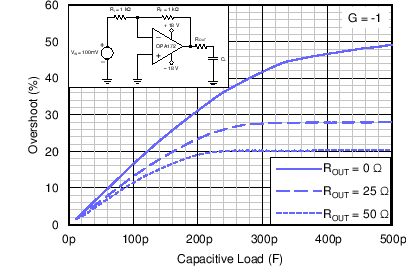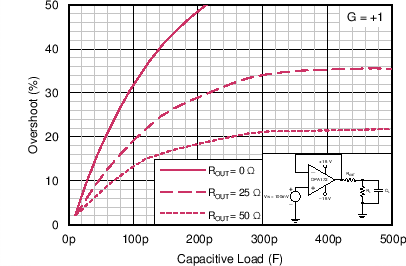ZHCSBX8I December 2013 – May 2018 OPA172 , OPA2172 , OPA4172
PRODUCTION DATA.
- 1 特性
- 2 应用
- 3 说明
- 4 修订历史记录
- 5 Device Comparison
- 6 Pin Configuration and Functions
- 7 Specifications
- 8 Detailed Description
- 9 Applications and Implementation
- 10Power-Supply Recommendations
- 11Layout
- 12器件和文档支持
- 13机械、封装和可订购信息
封装选项
机械数据 (封装 | 引脚)
散热焊盘机械数据 (封装 | 引脚)
订购信息
8.3.3 Capacitive Load and Stability
The dynamic characteristics of the OPAx172 are optimized for commonly-used operating conditions. The combination of low closed-loop gain and high capacitive loads decreases the phase margin of the amplifier and may lead to gain peaking or oscillations. As a result, heavier capacitive loads must be isolated from the output. The simplest way to achieve this isolation is to add a small resistor (for example, ROUT = 50 Ω) in series with the output. Figure 44 and Figure 45 show graphs of small-signal overshoot versus capacitive load for several values of ROUT. Refer to Application Bulletin SBOA015 (AB-028), Feedback Plots Define Op Amp AC Performance, available for download from www.ti.com, for details of analysis techniques and application circuits.
 Figure 44. Small-Signal Overshoot vs Capacitive Load (100-mV Output Step)
Figure 44. Small-Signal Overshoot vs Capacitive Load (100-mV Output Step)  Figure 45. Small-Signal Overshoot vs Capacitive Load (100-mV Output Step)
Figure 45. Small-Signal Overshoot vs Capacitive Load (100-mV Output Step)